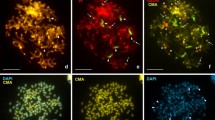Abstract
Chromatin diminution is the loss of selected regions of pre-somatic cell chromosomes during early development, resulting in the removal of a large amount of the genomic DNA from the pre-somatic cells. In copepods, diminution is characterized by the formation of heterochromatically staining regions, or H-segments, which contain the chromatin to be lost. The removal of H-segments during diminution also must represent a major restructuring of the chromosomes which contained them. In order to examine the effects of diminution on the morphology and structure of the chromosomes, the C-banding technique was used. This procedure revealed that most C-bands present in the pre-diminution complement were absent in the post-diminution set. Additionally, in order to explore further the possible composition of the DNA contained in H-segments, a comparison, based on the relationship of C-bands to highly-repetitive DNA in chromosomes, was made between pre-diminution C-bands and H-segments. This comparison showed that not all H-segments are at chromosomal locations which produce a C-band, indicating that H-segments are perhaps not entirely composed of genetically inert DNA, as is currently supposed.
Similar content being viewed by others
References
Aeby, P., Spicher, A., deChastonay, V., Muller, F. & Tobler, H., 1986. Structure and genomic organization of preretrovirus-like elements partially eliminated from the somatic genome of Ascaris lumbricoides. EMBO 5 (12): 3353–3360.
Akifjev, A. P., 1974. DNA which keeps silent and its role in evolution. (Russ.) Priroda (USSR) 9: 49–54.
Arnold, M. L. & Shaw, D. D., 1985. The heterochromatin of grasshoppers from the Caledia captiva species complex. II. Cytological organisation of tandemly repeated DNA sequences. Chromosoma 93: 183–190.
Arrighi, F. E. & Hsu, T. C., 1971. Localization of heterochromatin in human chromosomes. Cytogenetics 10: 81–86.
Beermann, S., 1959. Chromatin-Diminution bei Copepoden. Chromosoma 10: 504–514.
Beermann, S., 1966. A quantitative study of chromatin diminution in embryonic mitosis of Cyclops furcifer. Genetics 54: 567–576.
Beermann, S., 1977. The diminution of heterochromatic chromosomal segments in Cyclops (Crustacea, Copepoda). Chromosoma 60: 297–344.
Beermann, S., 1984. Circular and linear structures in chromatin diminution of Cyclops. Chromosoma 89: 321–328.
Beermann, S. & Meyer, G. F., 1980. Chromatin rings as products of chromatin diminution in Cyclops. Chromosoma 77: 277–283.
Brandl, Z., 1973. Laboratory culture of cyclopoid copepods on a definite food. Vestnik Cs. spol. zool. 37: 81–88.
Brown, S. W. & Nur, U., 1958. Heterochromatin chromosomes in the coccids. Science 145: 130–136.
Callan, H. G., 1982. Lampbrush chromosomes. Proc. R. Soc. Lond. [Biol] 214: 417–448.
Chinnappa, C. C., 1980. Bivalent forming race of Mesocyclops edax (Copepoda, Crustacea) Can. J. Genet. Cytol. 22: 427–431.
Cleffman, G., 1980. Chromatin elimination and the genetic organization in the macronucleus of Tetrahymena thermophila. Chromosoma 78: 313–325.
Jack, E. M., Harrison, C. J., Allen, T. D. & Harris, R., 1985. The structural basis for C-banding: a scanning electron microscopy study. Chromosoma 91: 363–368.
Kaulenas, M. S. & Fairbairn, D., 1968. RNA metabolism of fertilized Ascaris lumbricoides eggs during uterine development. Expl Cell Res. 52: 233–251.
McKay, R. D. G., 1973. The mechanism of G and C banding in mammalian metaphase chromosomes. Chromosoma 44: 1–14.
Meyer, G. F. & Lipps, H. J., 1980. Chromatin elimination in the hypotrichous ciliate Stylonchia mytilus. Chromosoma 77: 285–297.
Nichols, H. W. & Bold, H. C., 1965. Trichosarcina polymorpha. Gen. Sp. Nov. J. Phycol. 1: 34–38.
Pardue, M. L. & Gall, J. G., 1970. Chromosomal localization of mouse satellite DNA. Science 168: 1356–1358.
Pennak, R. W., 1963. Species identification of the fresh-water cyclopoid copepoda of the United States. Trans. Am. Microscopical Soc. 82: 353–359.
Rieffel, S. M. & Crouse, H. V., 1966. The elimination and differentiation of chromosomes in the germ-line of Sciara. Chromosoma 19: 231–276.
Roth, G. E. & Moritz, K. B., 1981. Restriction enzyme analysis of the germ-line limited DNA of Ascaris suum. Chromosoma 83: 169–190.
Rüsch, M. E., 1960. Untersuchungen über Geschlechtsbe-stimmungsmechanismen bei Copepoden. Chromosoma 11: 619–632.
Rylov, V. M., 1963. Fauna of U.S.S.R. Crustacea Volume III No. 3 Israel Program for Scientific Translations, Jerusalem.
Smith, K. & Fernando, C. H., 1978. A Guide to the Fresh-water Calanoid and Cyclopoid Copepod Crustacea of Ontario. University of Waterloo Biology Series No. 18.
Sumner, A. T., 1972. A simple technique for demonstrating centromeric heterochromatin. Expl Cell Res. 75: 304–306.
Tobler, H., 1986. The differentiation of germ and somatic cell lines in nemotodes. In: W.Hennig (ed.), Germ Line-Soma Differentiation. Results and problems in cell differentiation Vol. 13. Springer-Verlag. Berlin/ Heidelberg/ New York/ Tokyo.
Tobler, H., Smith, K. D. & Ursprung, H., 1972. Molecular aspects of chromatin elimination in Ascaris lumbricoides. Dev. Biol. 27: 190–203.
Yeatman, H. C., 1944. American cyclopoid copepods of the viridis-vernalis group (including a deseription of Cyclops carolinianus n.sp.). Am. Midland Naturalist 32: 1–90.
Author information
Authors and Affiliations
Rights and permissions
About this article
Cite this article
Standiford, D.M. The effects of chromatin diminution on the pattern of C-banding in the chromosomes of Acanthocyclops vernalis Fischer (Copepoda: Crustacea). Genetica 79, 207–214 (1989). https://doi.org/10.1007/BF00121514
Received:
Accepted:
Issue Date:
DOI: https://doi.org/10.1007/BF00121514




